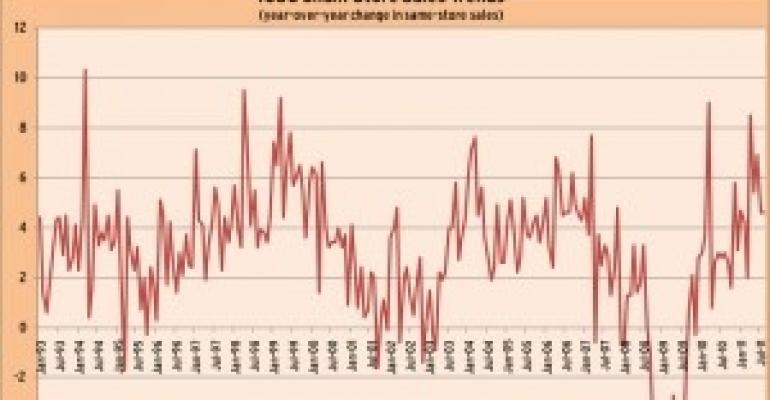August same-store sales rose by between 4.5 percent and 5.0 percent.
The gains were not divided equally, however, as specialty retailers benefited from back-to-school shopping, while department store operators suffered a drop in weekend traffic at the end of the month because of Hurricane Irene.
Macy's Inc. (M), Saks Inc. (SKS) and other retailers closed locations along the East Coast as Hurricane Irene flooded roads, shut airports and cut power to more than 8 million homes and businesses. The storm struck the weekend before the Labor Day holiday, traditionally a key time for back-to-school shopping, Retail Metrics said in the report.Overall, back-to-school sales are strong, Jennifer Davis, an analyst at Lazard Capital Markets in New York, said in an interview. But it's difficult for department stores to recover from that closure, especially during such a key shopping weekend.
Despite the numbers, as we've written in other monthly roundups, it's important that we remember that the pool of retailers that still report same-store sales numbers is considerably smaller than it once was. Less than 30 retailers use the metric (down from more than 70 a few years ago). Wal-Mart stores, which singlehandedly accounts for roughly 5 percent to 6 percent of the overall retail pie, only reports quarterly figures today. And it has reported comparable store sales declines (excluding fuel sales) for nine straight quarters.
Were they still in the monthly matrix, the figures would look quite a bit different.
Our look inside the monthly reports is after the jump.
Thomson Reuters and ICSC reported a 4.6 percent gain, while Retail Sails said sales increased 4.9 percent and Kantar Retail said the increase was 4.8 percent.
ICSC
ICSC's tally shows that same-store sales rose 4.6 percent in August based on the results of 26 retailers, continuing the trend seen in July, when the retailers ICSC tracks also posted a 4.6 percent increase.
From its monthly write-up:
The stock‐up effect ahead of the hurricane helped some retailers (as consumers purchased emergency supplies and food), but hurt others that sold more discretionary items (apparel, for example). Industry wide, ICSC estimates that the hurricane impact pared the August pace ofcomparable‐store sales by approximately 0.5 to 1.0 percentage points. However, the impacts for individual retailers varied widely.
Macy's CEO noted that his company was negatively impacted by Irene. He opined that he was very pleased with [his company's] August sales results, especially considering that more than 100 [of the
company's] stores, including some of the largest‐volume locations in [his] company, were closed for all or part of Saturday on a very important shopping weekend because of Hurricane Irene. Macy's estimated that same‐store sales for the month of August would have been approximately 1.5 percentage points higher if not for the store closings and reduced customer traffic caused by the hurricane.
Kohl's and JC Penney posted comp‐store sales declines in August. JC Penney attribted its weakness to the back‐to‐school selling season [that] started later again this year and the company's sales during the last week of August were negatively impacted by the significant disruption in the northeast and southeast regions of the country caused by Hurricane Irene..
Here are ICSC's monthly same-store sales year-over-year changes, not seasonally adjusted, going back to 1993.
Click to enlarge.
Here is ICSC's index of same-store sales, seasonally adjusted, going back to 1992.
Click to enlarge.
Kantar Retail
According to Kantar Retail, sales-weighted same-store sales increased 4.8 percent in August for the 26 retailers that reported numbers (most of which were apparel retailers). (A pdf with each retailer's results can be downloaded here.) The results were on par with a 4.8 percent gain in July.
According to Kantar, the results were led by stronger-than-average gains at food, drug and mass retailers, many of whom benefited from consumers stocking up on essentials in preparation for Hurricane Irene. On the other hand, apparel, accessories and department stores were hurt by the Hurricane.
Frank Badillo, senior economist at Kantar Retail, said in a statement, Shoppers are clearly moving to curb their spending, although it's hard to see amid the impact of the hurricane and unavoidable back-to-school spending.
Here are two charts from Kantar's Shopperscape survey. The firm expects weakening spending intentions among consumers in the coming months.
Click to enlarge.
Click to enlarge.
RetailSails
Blog RetailSails measured a 4.9 percent gain, looking at 24 retailers in its sales summary.
The best performing chains were warehouse clubs and discounters, as they were able to lure shoppers making hurricane preparations and buying basic necessities such as batteries and water, while passing on much of their food inflation onto consumers. Costco (+11%, +7% ex gas & f/x) and BJ's Wholesale (+11.5%, +7.9% ex gas) have exposure to upper-income consumers and continue to steal market share from other discounters and dollar stores.Performance at department stores, which have been expanding market share after nearly a decade of contraction, was mixed for the month. Gainers were led by Dillard's (+4%) and Macy's (+5.0%), who can thank surging online sales, which rose 35.5% during July and are up 38.7% year-to-date, for much of its success. Kohl's (-1.9%) and JC Penney (+1.9%), however struggled during August and Kohl's CEO Kevin Mansell said We are aggressively increasing our marketing as well as sharpening our pricing focus for the remainder of the fall season to reverse this trend.
Several chains, especially those with heavy exposure to the East Coast, said Hurricane Irene took the wind out of what was shaping up to be a strong month. The overall effects on retailers ranged from minimal to a 1.5% hit to comps. However, August results really just continued the trend of the strong chains separating themselves from weaker rivals.





